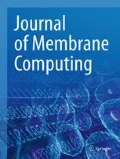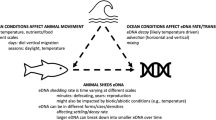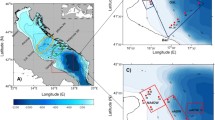Abstract
Diel vertical migration (DVM) is an important ecological phenomenon in which zooplankton migrate vertically to deal with trade-offs associated with greater food availability in shallow waters and lower predator risk in deep waters due to lower light availability. Because of these trade-offs, DVM dynamics are particularly sensitive to changes in light intensity at the water surface. Therefore, changes in the proportion of cloudy and sunny days have the potential to disrupt DVM dynamics. We propose a new membrane computing model that captures the effect of cloud cover on DVM in Daphnia, and we use it to explore the impacts of an increased proportion of cloudy days that are predicted to occur with climate change. Our 2-dimensional, spatially explicit model integrates multiple trophic levels from abiotic nutrients to Daphnia predators. We analyzed the effect that different proportions of cloudy and sunny days throughout the summer have on our model. The model simulations suggest that an increase in sunny days promotes a high phytoplankton concentration near the surface but does not necessarily promote an increased abundance of Daphnia. Our model also suggests that a higher proportion of cloudy days would increase Daphnia abundance due to a shift in the vertical distribution of Daphnia populations towards superficial waters. Our results highlight that climate changes in multiple regions will affect animal migrations leading to altered food web dynamics in freshwater ecosystems, and emphasize the potential of membrane computing as a modeling framework for spatially and temporally explicit ecological processes.





Similar content being viewed by others
References
Abbaspour, K. C., Yang, J., Maximov, I., Siber, R., Bogner, K., Mieleitner, J., et al. (2007). Modelling hydrology and water quality in the pre-alpine/alpine Thur watershed using SWAT. Journal of Hydrology, 333(2–4), 413–430. https://doi.org/10.1016/j.jhydrol.2006.09.014.
Allan, M. G., Hamilton, D. P., Trolle, D., Muraoka, K., & McBride, C. (2016). Spatial heterogeneity in geothermally-influenced lakes derived from atmospherically corrected Landsat thermal imagery and three-dimensional hydrodynamic modelling. International Journal of Applied Earth Observation and Geoinformation, 50, 106–116. https://doi.org/10.1016/J.JAG.2016.03.006.
Barbuti, R., Bove, P., Milazzo, P., & Pardini, G. (2015). Minimal probabilistic P systems for modelling ecological systems. Theoretical Computer Science, 608(Part 1), 36–56. https://doi.org/10.1016/j.tcs.2015.07.035.
Beletsky, D., Schwab, D., Mason, D., Rutherford, E., McCormick, M., Vanderploeg, H., & Janssen, J. (2003). Modeling the transport of larval Yellow Perch in Lake Michigan. In: Estuarine and coastal modeling (pp. 439–454). Reston, VA: American Society of Civil Engineers (2004). https://doi.org/10.1061/40734(145)28
Berec, L. (2002). Techniques of spatially explicit individual-based models: Construction, simulation, and mean-field analysis. Ecological Modelling, 150(1–2), 55–81. https://doi.org/10.1016/S0304-3800(01)00463-X.
Berger, J., Young, J. K., & Berger, K. M. (2008). Protecting migration corridors: Challenges and optimism for Mongolian Saiga. PLoS Biology, 6(7), e165. https://doi.org/10.1371/journal.pbio.0060165.
Besozzi, D., Cazzaniga, P., Pescini, D., & Mauri, G. (2008). Modelling metapopulations with stochastic membrane systems. Biosystems, 91(3), 499–514. https://doi.org/10.1016/j.biosystems.2006.12.011.
Bollens, S. M., Frost, B. W., & Cordell, J. R. (1994). Chemical, mechanical and visual cues in the vertical migration behavior of the marine planktonic copepod Acartia hudsonica. Journal of Plankton Research, 16(5), 555–564. https://doi.org/10.1093/plankt/16.5.555.
Boriss, H., & Gabriel, W. (1998). Vertical migration in Daphnia: The role of phenotypic plasticity in the migration pattern for competing clones or species. Oikos, 83(1), 129. https://doi.org/10.2307/3546553.
Brewer, M. C., Dawidowicz, P., & Dodson, S. I. (1999). Interactive effects of fish kairomone and light on Daphnia escape behavior. Journal of Plankton Research, 21(7), 1317–1335. https://doi.org/10.1093/plankt/21.7.1317.
Burns, C. W. (1969). Relation between filtering rate, temperature, and body size in four species of Daphnia. Limnology and Oceanography, 14(5), 693–700. https://doi.org/10.4319/lo.1969.14.5.0693.
Cao, J., Guan, W., Truesdell, S., Chen, Y., & Tian, S. (2016). An individual-based probabilistic model for simulating fisheries population dynamics. Aquaculture and Fisheries, 1, 34–40. https://doi.org/10.1016/j.aaf.2016.10.001.
Cardona, M., Colomer, M. A., Margalida, A., Palau, A., Pérez-Hurtado, I., Pérez-Jiménez, M. J., & Sanuy, D. (2011). A computational modeling for real ecosystems based on P systems. In: Natural computing (Vol. 1, pp. 39–53). Springer. https://doi.org/10.1007/s11047-010-9191-3.
Cerco, C. F. (1995). Simulation of long-term trends in Chesapeake Bay eutrophication. Journal of Environmental Engineering, 121(4), 298–310. https://doi.org/10.1061/(ASCE)0733-9372(1995)121:4(298).
Cerco, C. F., & Meyers, M. (2000). Tributary refinements to Chesapeake Bay Model. Journal of Environmental Engineering, 126(2), 164–174. https://doi.org/10.1061/(ASCE)0733-9372(2000)126:2(164).
Chau, K. W., & Jin, H. (1998). Eutrophication model for a Coastal Bay in Hong Kong. Journal of Environmental Engineering, 124(7), 628–638. https://doi.org/10.1061/(ASCE)0733-9372(1998)124:7(628).
Ciencialová, L., Csuhaj-Varjú, E., Cienciala, L., & Sosík, P. (2019). P colonies. Journal of Membrane Computing, 1(3), 178–197. https://doi.org/10.1007/s41965-019-00019-w.
Colomer, M., Lavín, S., Marco, I., Margalida, A., Pérez-Hurtado, I., Pérez-Jiménez, M., Sanuy, D., Serrano, E., & Valencia-Cabrera, L. (2011). Modeling population growth of Pyrenean chamois (Rupicapra p. pyrenaica) by using p-systems. In: M. Gheorghe, T. Hinze, G. Păun, G. Rozenberg, A. Salomaa (Eds.) Membrane Computing, Lecture Notes in Computer Science (Vol. 6501, pp. 144–159). Berlin: Springer. https://doi.org/10.1007/978-3-642-18123-8_13.
Colomer, M. A., Margalida, A., & Pérez-Jiménez, M. J. (2013). Population dynamics P aystem (PDP) models: A standardized protocol for describing and applying novel bio-inspired computing tools. PLoS ONE, 8(4), e60698. https://doi.org/10.1371/journal.pone.0060698.
Colomer, M. A., Margalida, A., Sanuy, D., & Pérez-Jiménez, M. J. (2011). A bio-inspired computing model as a new tool for modeling ecosystems: The avian scavengers as a case study. Ecological Modelling, 222(1), 33–47. https://doi.org/10.1016/j.ecolmodel.2010.09.012.
Colomer, M. A., Margalida, A., Valencia, L., & Palau, A. (2014). Application of a computational model for complex fluvial ecosystems: The population dynamics of zebra mussel Dreissena polymorpha as a case study. Ecological Complexity, 20, 116–126. https://doi.org/10.1016/j.ecocom.2014.09.006.
Colomer-Cugat, M. A., García-Quismondo, M., Macías-Ramos, L. F., Martínez-del Amor, M. A., Pérez-Hurtado, I., Pérez-Jiménez, M. J., Riscos-Núñez, A., & Valencia-Cabrera, L. (2014). Membrane system-based models for specifying dynamical population systems (pp. 97–132). Cham: Springer International Publishing. https://doi.org/10.1007/978-3-319-03191-0_4.
Cooke, S. L., Williamson, C. E., Leech, D. M., Boeing, W. J., & Torres, L. (2008). Effects of temperature and ultraviolet radiation on diel vertical migration of freshwater crustacean zooplankton. Canadian Journal of Fisheries and Aquatic Sciences, 65(6), 1144–1152. https://doi.org/10.1139/F08-039.
Coumou, D., & Rahmstorf, S. (2012). A decade of weather extremes. Nature Climate Change, 2(7), 491. https://doi.org/10.1038/nclimate1452.
Dodson, S. (1990). Predicting diel vertical migration of zooplankton. Limnology and Oceanography, 35(5), 1195–1200. https://doi.org/10.4319/lo.1990.35.5.1195.
Dodson, S. I., Tollrian, R., & Lampert, W. (1997). Daphnia swimming behavior during vertical migration. Tech. Rep. 8. https://academic.oup.com/plankt/article-abstract/19/8/969/1471878.
Eiane, K., & Parisi, D. (2001). Towards a robust concept for modelling zooplankton migration. Sarsia, 86(6), 465–475. https://doi.org/10.1080/00364827.2001.10420486.
Elert, E. V., & Pohnert, G. (2000). Predator specificity of kairomones in diel vertical migration of Daphnia: a chemical approach. Oikos, 88(1), 119–128. https://doi.org/10.1034/j.1600-0706.2000.880114.x.
Fiksen, Ø. (1997). Allocation patterns and diel vertical migration: Modeling the optimal Daphnia. Ecology, 78(5), 1446–1456. https://doi.org/10.1890/0012-9658(1997)078[1446:APADVM]2.0.CO;2.
Fischer, J. M., Nicolai, J. L., Williamson, C. E., Persaud, A. D., & Lockwood, R. S. (2006). Effects of ultraviolet radiation on diel vertical migration of crustacean zooplankton: An in situ mesocosm experiment. Hydrobiologia, 563(1), 217–224. https://doi.org/10.1007/s10750-005-0007-x.
García-Quismondo, M. (2014). Modelling and simulation of real-life phenomena in membrane computing. Ph.D. thesis, Department of Computer Science and Artificial Intelligence. University of Sevilla.
García-Quismondo, M., Martínez-del-Amor, M. A., & Pérez-Jiménez, M. J. (2015). Probabilistic guarded P systems, a new formal modelling framework. Lecture Notes in Computer Science, 8961(1), 194–214.
García-Quismondo, M., Levin, M., & Lobo, D. (2017). Modeling regenerative processes with membrane computing. Information Sciences, 381, 229–249. https://doi.org/10.1016/j.ins.2016.11.017.
García-Quismondo, M., Reed, J. M., Chew, F. S., del Amor, M. A. M., & Pérez-Jiménez, M. J. (2017). Evolutionary response of a native butterfly to concurrent plant invasions: Simulation of population dynamics. Ecological Modelling, 360, 410–424. https://doi.org/10.1016/j.ecolmodel.2017.06.030.
Gin, K. Y. H., Zhang, Q. Y., Chan, E. S., & Chou, L. M. (2001). Three-dimensional ecological-eutrophication model for Singapore. Journal of Environmental Engineering, 127(10), 928–937. https://doi.org/10.1061/(ASCE)0733-9372(2001)127:10(928).
van Gool, E., & Ringelberg, J. (1997). The effect of accelerations in light increase on the phototactic downward swimming of Daphnia and the relevance to diel vertical migration. Journal of Plankton Research, 19(12), 2041–2050. https://doi.org/10.1093/plankt/19.12.2041.
Grimm, V. (1999). Ten years of individual-based modelling in ecology: What have we learned and what could we learn in the future? Ecological Modelling, 115(2), 129–148. https://doi.org/10.1016/S0304-3800(98)00188-4.
Grimm, V., Wyszomirski, T., Aikman, D., & Uchmański, J. (1999). Individual-based modelling and ecological theory: Synthesis of a workshop. Ecological Modelling, 115(2), 275–282. https://doi.org/10.1016/S0304-3800(98)00186-0.
Han, B. P., & Straškraba, M. (2001). Control mechanisms of diel vertical migration: Theoretical assumptions. Journal of Theoretical Biology, 210(3), 305–318. https://doi.org/10.1006/JTBI.2001.2307.
Hansson, L. A., & Hylander, S. (2009). Size-structured risk assessments govern Daphnia migration. Proceedings of the Royal Society B: Biological Sciences, 276(276), 331–336. https://doi.org/10.1098/rspb.2008.1088.
Hays, G. C. (2003). A review of the adaptive significance and ecosystem consequences of zooplankton diel vertical migrations. Hydrobiologia, 503(1–3), 163–170. https://doi.org/10.1023/B:HYDR.0000008476.23617.b0.
Hoellein, T. J., Bruesewitz, D. A., & Hamilton, D. P. (2012). Are geothermal streams important sites of nutrient uptake in an agricultural and urbanising landscape (Rotorua, New Zealand)? Freshwater Biology, 57(1), 116–128. https://doi.org/10.1111/j.1365-2427.2011.02702.x.
Huntley, B., Collingham, Y. C., Green, R. E., Hilton, G. M., Rahbek, C., & Willis, S. G. (2006). Potential impacts of climatic change upon geographical distributions of birds. Ibis, 148, 8–28. https://doi.org/10.1111/j.1474-919X.2006.00523.x.
Hylander, S., Larsson, N., & Hansson, L. A. (2009). Zooplankton vertical migration and plasticity of pigmentation arising from simultaneous UV and predation threats. Limnology and Oceanography, 54(2), 483–491. https://doi.org/10.4319/lo.2009.54.2.0483.
Juayong, R. A. B., & Adorna, H. N. (2020). A survey of results on evolution-communication P systems with energy. Journal of Membrane Computing, 2(1), 59–69. https://doi.org/10.1007/s41965-020-00034-2.
Kessler, K., & Lampert, W. (2004). Depth distribution of Daphnia in response to a deep-water algal maximum: The effect of body size and temperature gradient. Freshwater Biology, 49(4), 392–401. https://doi.org/10.1111/j.1365-2427.2004.01190.x.
Laaksonen, T., Ahola, M., Eeva, T., Väisänen, R., & Lehikoinen, E. (2006). Climate change, migratory connectivity and changes in laying date and clutch size of the pied flycatcher. Oikos, 114(2), 277–290. https://doi.org/10.1111/j.2006.0030-1299.14652.x.
Lampert, W. (1989). The adaptive significance of diel vertical migration of zooplankton. Functional Ecology, 3(1), 21. https://doi.org/10.2307/2389671.
Leporati, A., Manzoni, L., Mauri, G., Porreca, A. E., & Zandron, C. (2020). Shallow laconic P systems can count. Journal of Membrane Computing, 2(1), 49–58. https://doi.org/10.1007/s41965-020-00032-4.
Loose, C. J., & Dawidowicz, P. (1994). Trade-offs in diel vertical migration by zooplankton: The costs of predator avoidance. Ecology, 75(8), 2255. https://doi.org/10.2307/1940881.
Morozov, A. Y., Petrovskii, S. V., & Nezlin, N. P. (2007). Towards resolving the paradox of enrichment: The impact of zooplankton vertical migrations on plankton systems stability. Journal of Theoretical Biology, 248(3), 501–511. https://doi.org/10.1016/J.JTBI.2007.05.028.
Orellana-Martín, D., Valencia-Cabrera, L., Riscos-Núñez, A., & Pérez-Jiménez, M. J. (2019). Minimal cooperation as a way to achieve the efficiency in cell-like membrane systems. Journal of Membrane Computing, 1(2), 85–92. https://doi.org/10.1007/s41965-018-00004-9.
Park, R. A., Clough, J. S., & Wellman, M. C. (2008). AQUATOX: Modeling environmental fate and ecological effects in aquatic ecosystems. Ecological Modelling, 213(1), 1–15. https://doi.org/10.1016/j.ecolmodel.2008.01.015.
Pinheiro, J., Bates, D., DebRoy, S., & Sarkar, D. (2017). R Core Team: nlme: Linear and nonlinear mixed effects models. https://cran.r-project.org/package=nlme.
Păun, G. (2000). Computing with membranes. Journal of Computer and System Sciences, 61(1), 108–143. https://doi.org/10.1006/jcss.1999.1693.
R Core Team. (2017). R: A language and environment for statistical computing. Vienna: R Foundation for Statistical Computing. https://www.r-project.org/.
Ramos-Jiliberto, R., & González-Olivares, E. (2000). Relating behavior to population dynamics: A predator-prey metaphysiological model emphasizing zooplankton diel vertical migration as an inducible response. Ecological Modelling, 127(2–3), 221–233. https://doi.org/10.1016/S0304-3800(99)00214-8.
Richards, S. A., Possingham, H. P., & Noye, J. (1996). Diel vertical migration: modelling light-mediated mechanisms. Journal of Plankton Research, 18(12), 2199–2222. https://doi.org/10.1093/plankt/18.12.2199.
Rinke, K., & Petzoldt, T. (2003). Modelling the effects of temperature and food on individual growth and reproduction of Daphnia and their consequences on the population level. Limnologica - Ecology and Management of Inland Waters, 33(4), 293–304. https://doi.org/10.1016/S0075-9511(03)80024-5.
Rinke, K., Petzoldt, T. (2008). Individual-based simulation of diel vertical migration of Daphnia: A synthesis of proximate and ultimate factors. Limnologica - Ecology and Management of Inland Waters 38(3-4), 269–285. https://doi.org/10.1016/j.limno.2008.05.006. http://linkinghub.elsevier.com/retrieve/pii/S0075951108000297.
Rose, K. C., Williamson, C. E., Fischer, J. M., Connelly, S. J., Olson, M., Tucker, A. J., et al. (2012). The role of ultraviolet radiation and fish in regulating the vertical distribution of Daphnia. Limnology and Oceanography, 57(6), 1867–1876. https://doi.org/10.4319/lo.2012.57.6.1867.
Ryabov, A. B. (2012). Phytoplankton competition in deep biomass maximum. Theoretical Ecology, 5(3), 373–385. https://doi.org/10.1007/s12080-012-0158-0.
Samanta, S., Alquran, M., & Chattopadhyay, J. (2015). Existence and global stability of positive periodic solution of tri-trophic food chain with middle predator migratory in nature. Applied Mathematical Modelling, 39(15), 4285–4299. https://doi.org/10.1016/j.apm.2014.12.044.
Samanta, S., & Chattopadhyay, J. (2013). Effect of kairomone on predator-prey dynamics—A delay model. International Journal of Biomathematics, 06(05), 1350035. https://doi.org/10.1142/S1793524513500356.
Song, B., Li, K., Orellana-Martín, D., Valencia-Cabrera, L., & Pérez-Jiménez, M. J. (2020). Cell-like P systems with evolutional symport/antiport rules and membrane creation. Information and Computation,. https://doi.org/10.1016/j.ic.2020.104542.
Sydeman, W. J., García-Reyes, M., Schoeman, D. S., Rykaczewski, R. R., Thompson, S. A., Black, B. A., et al. (2014). Climate change and wind intensification in coastal upwelling ecosystems. Science, 345(6192), 77–80. https://doi.org/10.1126/science.1251635.
Visser, M. E., Perdeck, A. C., van Balen, J. H., & Both, C. (2009). Climate change leads to decreasing bird migration distances. Global Change Biology, 15(8), 1859–1865. https://doi.org/10.1111/j.1365-2486.2009.01865.x.
Wetzel, R. G. (2001). Limnology: Lake and river ecosystems. San Diego: Academic Press.
Wilcove, D. S., & Wikelski, M. (2008). Going, going, gone: Is animal migration disappearing. PLoS Biology, 6(7), e188. https://doi.org/10.1371/journal.pbio.0060188.
Williamson, C. E., Fischer, J. M., Bollens, S. M., Overholt, E. P., & Breckenridge, J. K. (2011). Toward a more comprehensive theory of zooplankton diel vertical migration: Integrating ultraviolet radiation and water transparency into the biotic paradigm. Limnology and Oceanography, 56(5), 1603–1623. https://doi.org/10.4319/lo.2011.56.5.1603.
Williamson, C. E., Zepp, R. G., Lucas, R. M., Madronich, S., Austin, A. T., Ballaré, C. L., et al. (2014). Solar ultraviolet radiation in a changing climate. Nature Climate Change, 4(6), 434–441. https://doi.org/10.1038/nclimate2225.
Xu, H., Paerl, H. W., Qin, B., Zhu, G., Hall, N. S., & Wu, Y. (2015). Determining critical nutrient thresholds needed to control harmful cyanobacterial blooms in Eutrophic Lake Taihu, China. Environmental Science & Technology, 49(2), 1051–1059. https://doi.org/10.1021/es503744q.
Acknowledgements
This work was supported by the Jefferson Project at Lake George, which is a collaboration between Rensselaer Polytechnic Institute, IBM, and The FUND for Lake George. The funding sources had no involvement in the model design, implementation and simulation, the writing of this article, or in the decision to submit this article for publication.
Author information
Authors and Affiliations
Corresponding author
Additional information
Publisher's Note
Springer Nature remains neutral with regard to jurisdictional claims in published maps and institutional affiliations.
Electronic supplementary material
Below is the link to the electronic supplementary material.
Rights and permissions
About this article
Cite this article
García-Quismondo, M., Hintz, W.D., Schuler, M.S. et al. Modeling diel vertical migration with membrane computing. J Membr Comput 3, 35–50 (2021). https://doi.org/10.1007/s41965-020-00038-y
Received:
Accepted:
Published:
Issue Date:
DOI: https://doi.org/10.1007/s41965-020-00038-y




